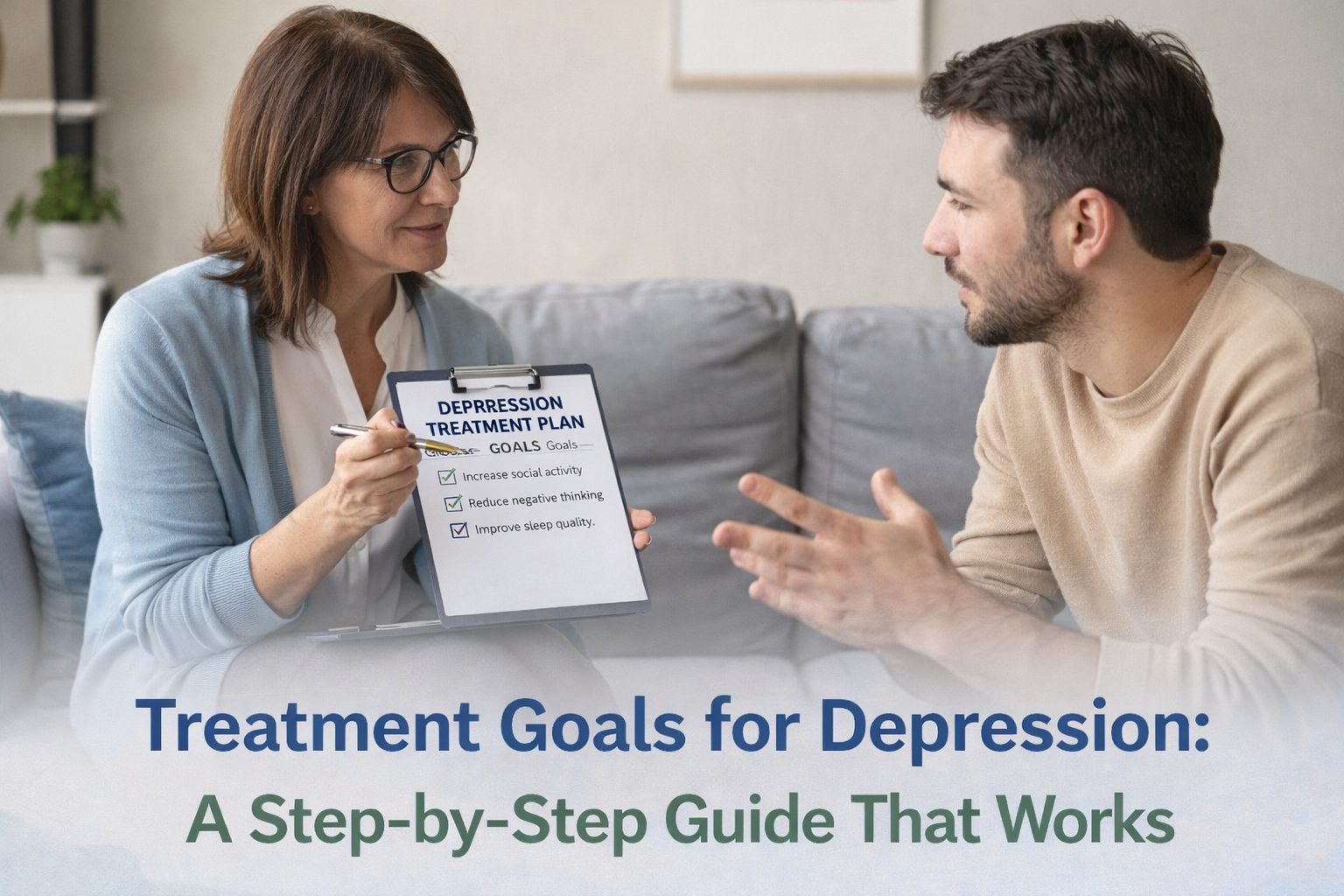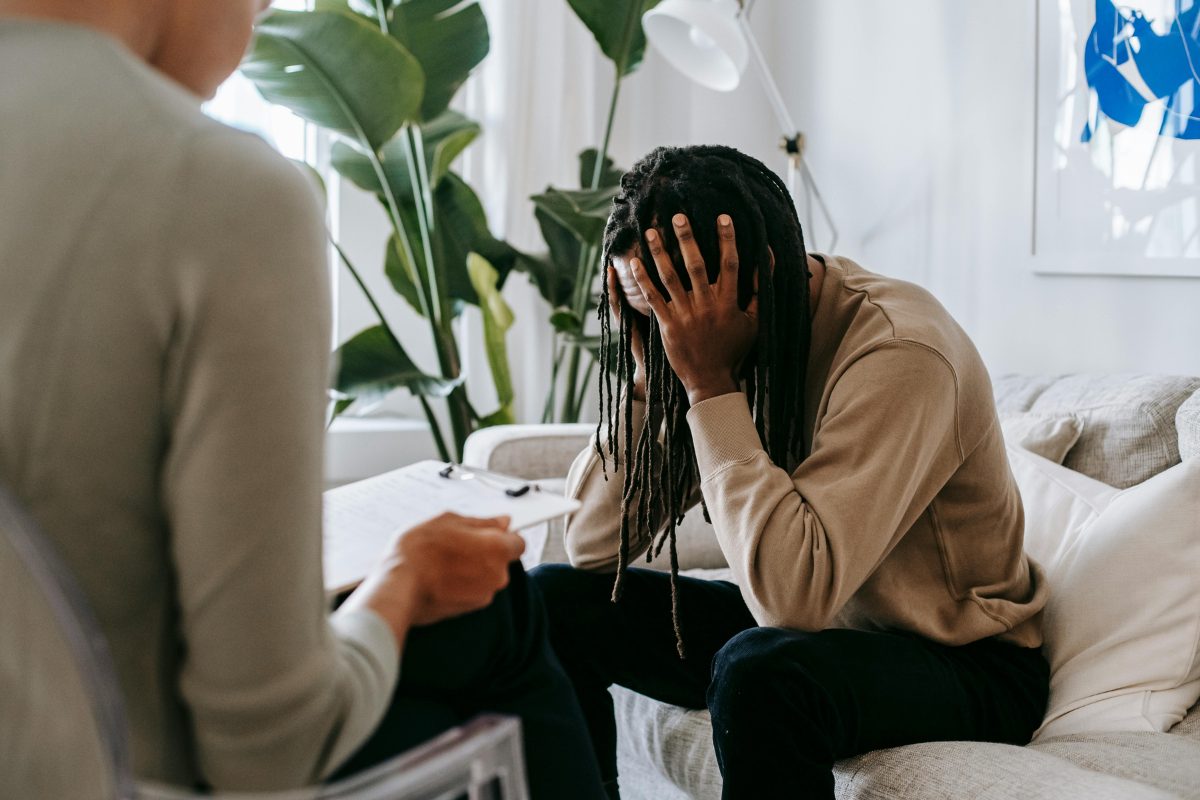Blog > Treatment Strategies > Top Interventions for Anxiety: Tools and Techniques for Clinicians
Effective Interventions for Anxiety: A Clinician’s Guide
This comprehensive guide outlines the most effective interventions for anxiety, including CBT, exposure therapy, mindfulness, and lifestyle strategies. Clinicians will learn how to categorize and implement anxiety treatment techniques using real-world examples and tools. Discover how ICANotes supports efficient documentation and better client outcomes for anxiety treatment.

Last Updated: August 14, 2025

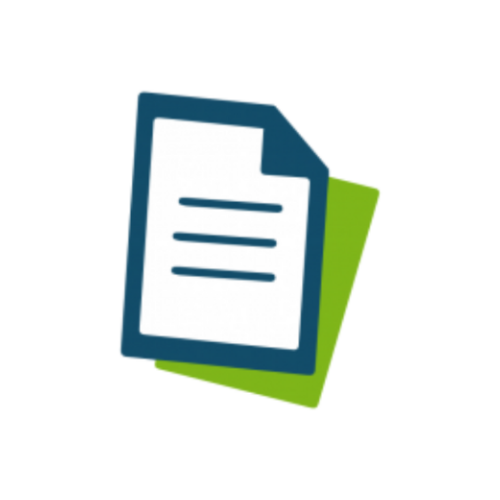
What You'll Learn
-
The five core categories of anxiety interventions—cognitive, behavioral, somatic, psychoeducational, and lifestyle—and how to apply them in practice
-
How to implement evidence-based techniques like CBT, graded exposure, mindfulness, and parental involvement
-
Real-world examples and tools for enhancing client engagement, such as symptom trackers, coping toolkits, and journaling prompts
-
How to use ICANotes to document anxiety treatment plans, interventions, and progress efficiently and compliantly
Anxiety is the most common mental health condition in the United States, affecting nearly 20% of the population annually. Given its widespread impact, effective interventions for anxiety are essential tools in every behavioral health clinician's repertoire. Whether your clients struggle with generalized anxiety, panic attacks, social fears, or obsessive thoughts, having a broad set of therapeutic techniques can help you tailor treatment to each individual. This guide outlines the most evidence-based and practical anxiety interventions to support your clients' progress.
Understanding Anxiety Disorders
Anxiety can have diverse presentations, but it generally involves fear, persistent worry, and anticipatory dread. While mild anxiety is necessary to keep us alert and prepared for danger, too much can impair our daily ability to function. Patients may come to see you after experiencing anxiety's physiological, cognitive, and emotional symptoms:
- Cognitive symptoms (e.g., racing thoughts, rumination)
- Emotional symptoms (e.g., irritability, dread)
- Physical symptoms (e.g., muscle tension, rapid heartbeat, insomnia)
Common anxiety disorders include:
- Generalized Anxiety Disorder (GAD)
- Social Anxiety Disorder
- Panic Disorder
- Specific Phobias
- Obsessive-Compulsive Disorder (OCD)
- Post-Traumatic Stress Disorder (PTSD)
Anxiety frequently co-occurs with other behavioral disorders, like depression, bipolar disorder, and attention-deficit hyperactive disorder, which can sometimes make it hard to diagnose or complicate the treatment plan. Clinicians must consider these related diagnoses when selecting interventions.
Core Interventions for Anxiety
Interventions for anxiety can be divided into five categories: cognitive, behavioral, somatic, psychoeducational, and lifestyle-based techniques. The following sections detail how these categories function and which evidence-based strategies fall into each one. For many clients, an integrated approach—blending cognitive, behavioral, somatic, and lifestyle interventions—yields the best outcomes, particularly when progress is measured regularly and interventions are adjusted as needed.
Cognitive Interventions
Cognitive interventions focus on helping clients identify, challenge, and reframe the unhelpful thought patterns that drive anxiety. These techniques promote greater insight, reduce cognitive distortions, and foster long-term emotional resilience.
1. Cognitive-Behavioral Therapy (CBT)
CBT is one of the most widely researched and effective anxiety treatments. It focuses on identifying, understanding, and reframing thoughts to achieve desired behavioral outcomes. Since anxiety often stems from distorted thinking patterns, CBT helps clients recognize irrational beliefs and restructure them. For example, clients may challenge catastrophic thinking or practice exposure in combination with thought logs. CBT can be delivered individually or in group therapy formats.
2. Thought Challenging and Cognitive Restructuring
This technique helps clients take a step back from automatic anxious thoughts and evaluate them more rationally. Clinicians may use Socratic questioning ("What evidence supports this fear?") or work with clients to identify cognitive distortions such as black-and-white thinking or emotional reasoning. For instance, a client afraid of being bitten by a spider might explore the actual rarity of dangerous spiders in their region and develop a more balanced belief.
3. Acceptance and Cognitive Flexibility
Acceptance and Commitment Therapy (ACT) and Mindfulness-Based Cognitive Therapy (MBCT) teach clients to accept difficult thoughts and emotions without judgment. Instead of fighting anxious thoughts, clients learn to observe them with curiosity and refocus on actions that align with their values. This approach promotes psychological flexibility, especially for clients with chronic or treatment-resistant anxiety.
4. Journaling and Emotional Processing
Structured journaling allows clients to identify anxiety triggers, log their emotional reactions, and track recurring thought patterns. Prompts such as "What was I afraid of today and how did I cope?" help clients build insight and connect thoughts to behaviors.
Need Quick Ideas for Therapy Interventions?
Download our free guide with evidence-based techniques, client-centered phrases, and tools for more effective, engaging sessions.
Behavioral Interventions
Behavioral interventions reduce anxiety by helping clients confront feared situations, break avoidance cycles, and develop practical coping skills. These action-oriented strategies are highly effective in treating a wide range of anxiety disorders.
5. Exposure Therapy
Exposure therapy involves systematically helping clients confront anxiety-provoking stimuli. It is especially effective for phobias, social anxiety, PTSD, and OCD. A client might begin with minor exposures—like viewing a photo of a feared object—and work toward more intense experiences, such as direct interaction. Combining exposure with relaxation training (systematic desensitization) can help pair anxiety triggers with calming responses.
6. In Vivo and Imaginal Exposure Techniques
In vivo exposure refers to confronting real-life feared situations, while imaginal exposure involves mentally visualizing distressing scenarios. For example, a client with PTSD might repeatedly recount a traumatic event in a safe setting, allowing desensitization over time. These methods require appropriate training and support from the clinician.
7. Group Therapy and Peer Support
Group-based interventions can normalize clients' experiences and reduce isolation. Group CBT programs or support groups help clients learn coping strategies from peers, practice exposure in social contexts, and receive validation. These formats are particularly effective for clients with social anxiety or generalized anxiety.
8. Skills Training and Coping Toolkits
Helping clients build a personalized set of coping tools enhances self-efficacy. These may include cue cards with positive affirmations, sensory tools like fidget objects, and structured worksheets for reframing anxious thoughts. You might also teach practical skills such as assertiveness, time management, or distress tolerance.
Somatic Interventions
Somatic techniques target the body’s stress response through mindfulness, relaxation, and movement-based practices. By calming the nervous system, these approaches help clients gain control over the physiological symptoms of anxiety.
9. Mindfulness and Acceptance Strategies
Mindfulness practices train clients to anchor their awareness in the present moment. Techniques include guided meditation, body scans, and breathing exercises. These tools can reduce reactivity and promote emotional regulation. ACT frequently incorporates mindfulness to help clients stay grounded during distress.
10. Relaxation Training
These methods target the physiological symptoms of anxiety. Diaphragmatic breathing activates the parasympathetic nervous system, while progressive muscle relaxation can ease chronic tension. Guided imagery and visualization offer a mental escape to calming environments. Clients should be encouraged to practice these regularly.
11. Creative and Expressive Therapies
Art therapy, music therapy, and movement-based expression provide nonverbal outlets for processing emotions. While clinicians may refer clients to credentialed creative arts therapists, general prompts like drawing an image of their anxiety or sculpting a "worry monster" can support insight and emotional release.
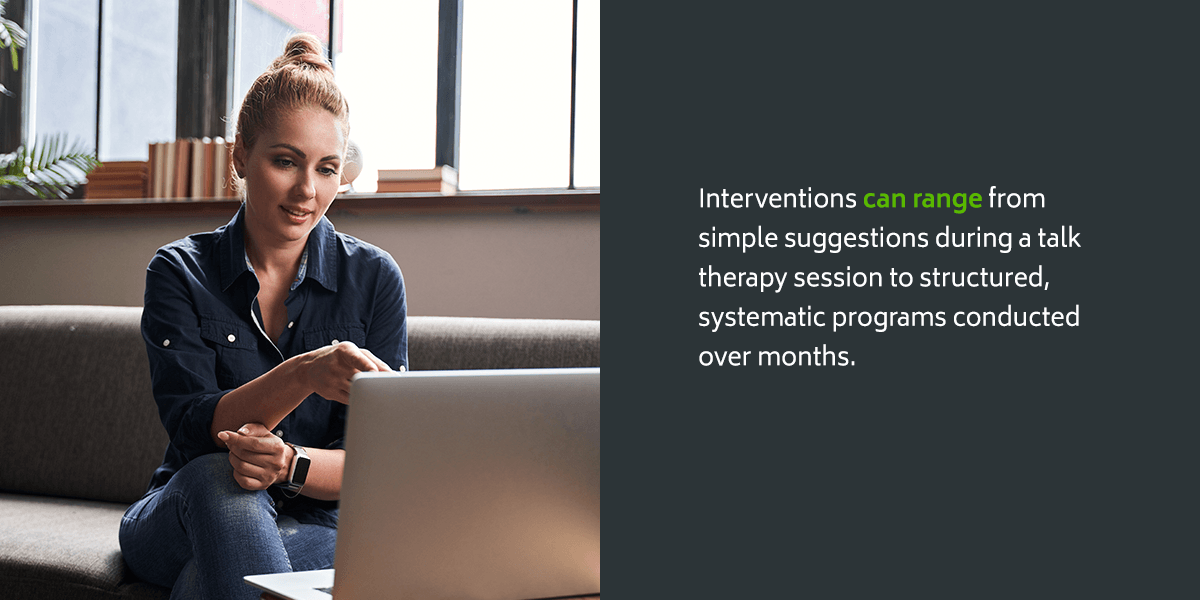
Psychoeducational Interventions
Psychoeducation helps clients understand the roots of their anxiety and learn evidence-based tools to manage it. These strategies increase treatment engagement, reduce stigma, and support behavior change between sessions.
12. Psychoeducation and Symptom Tracking
Educating clients about the physiological and psychological roots of anxiety can empower them and reduce shame. Clinicians might provide handouts, explain the fight-or-flight response, or walk clients through a stress cycle diagram. Encouraging clients to track symptoms in a journal or app also helps identify patterns and measure progress.
13. Homework and Digital Tools
Assigning clients between-session activities helps reinforce progress. These may include relaxation practice logs, thought records, or mood tracking apps. Some clients benefit from structured worksheets or gamified mental health tools. These resources encourage daily skill use and promote self-awareness.
14. Parental Involvement in Pediatric Cases
For children with anxiety, involving caregivers is key. Parents should be encouraged to model calm coping, avoid reinforcing avoidance behaviors, and create predictable routines. Clinicians can provide psychoeducation to parents and include them in goal setting and behavioral reinforcement.
Lifestyle Interventions
Lifestyle-focused interventions address the foundational habits that influence emotional well-being. Encouraging healthy sleep, nutrition, and physical activity can significantly enhance anxiety management and overall treatment outcomes.
15. Exercise, Diet, and Sleep Hygiene
Lifestyle factors strongly influence anxiety symptoms. Regular exercise (even short walks) releases endorphins and reduces cortisol. A balanced diet with stable blood sugar supports mood regulation, while consistent sleep patterns improve cognitive functioning. Clinicians can help clients identify barriers (e.g., time constraints, poor routines) and build realistic habits.
Summary of Anxiety Interventions by Category
| Category | Examples of Interventions |
|---|---|
| Cognitive | CBT, cognitive restructuring, journaling, ACT/MBCT |
| Behavioral | Exposure therapy, group therapy, skills training, in vivo/imaginal exposure |
| Somatic | Mindfulness, breathing exercises, progressive muscle relaxation, creative therapies |
| Psychoeducational | Psychoeducation, parental involvement, symptom tracking, therapeutic homework |
| Lifestyle | Physical activity, sleep routines, nutrition, caffeine/alcohol reduction |
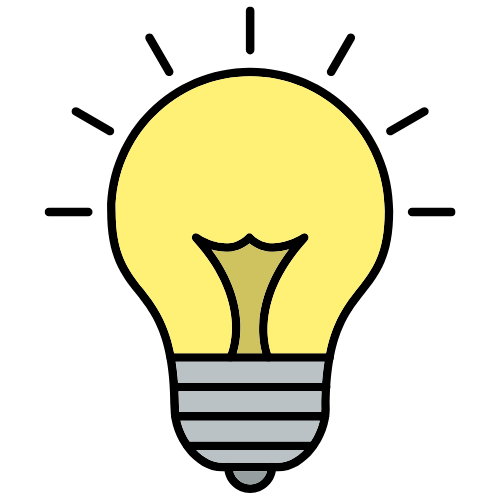
Clinical Implementation Examples
- CBT Thought Log Example: Client records the situation, automatic thought ("I'm going to fail"), evidence for/against, and replacement thought ("I've prepared and passed before").
- Graded Exposure Plan: Client with social anxiety ranks fear hierarchy from low (greeting a neighbor) to high (giving a presentation). Weekly exposure assignments are tracked and debriefed.
- Journaling Prompt Set: "What made me anxious today? What helped me cope? What do I wish I’d done differently?"
- Mindfulness Script Snippet: “Breathe in for four counts... hold... and breathe out slowly. Notice the ground beneath your feet.”
- Parent Coaching Tip: Reinforce independence by encouraging child to try anxiety-provoking task before offering reassurance.
Incorporating Anxiety Assessments for Outcomes Measurement
Standardized anxiety assessment tools can help clinicians measure anxiety severity, track treatment outcomes, and support documentation. Common assessments include:
- Generalized Anxiety Disorder-7 (GAD-7)
- Depression Anxiety Stress Scales (DASS-21)
- Zung Self-Rating Anxiety Scale
- Hamilton Anxiety Rating Scale (HAM-A)
These tools can be administered during intake, periodically during treatment, and at discharge.
Frequently Asked Questions
How ICANotes Supports Anxiety Intervention Documentation
High-quality documentation is essential when delivering structured interventions for anxiety. ICANotes, an EHR designed specifically for behavioral health providers, offers:
- Built-in anxiety assessments like the GAD-7
- Templates for CBT, ACT, exposure therapy, and psychoeducation
- Progress note and treatment plan templates tailored to behavioral interventions
Clinicians can save time, maintain compliance, and improve outcomes by integrating ICANotes into their practice.
Start Your Free Trial Today
Effective anxiety treatment requires a thoughtful combination of clinical skill and supportive tools. Whether you're using cognitive restructuring, exposure therapy, or mindfulness practices, your interventions are more powerful when backed by strong documentation and organization.
Get started with a free trial of ICANotes today — no credit card required — and see how a behavioral health EHR built for your needs can elevate your work with anxious clients.
Start Your 30-Day Free Trial
Experience the most intuitive, clinically robust EHR designed for behavioral health professionals, built to streamline documentation, improve compliance, and enhance patient care.
- Complete Notes in Minutes - Purpose-built for behavioral health charting
- Always Audit-Ready – Structured documentation that meets payer requirements
- Keep Your Schedule Full – Automated reminders reduce costly no-shows
- Engage Clients Seamlessly – Secure portal for forms, messages, and payments
- HIPAA-Compliant Telehealth built into your workflow
Complete Notes in Minutes – Purpose-built for behavioral health charting
Always Audit-Ready – Structured documentation that meets payer requirements
Keep Your Schedule Full – Automated reminders reduce costly no-shows
Engage Clients Seamlessly – Secure portal for forms, messages, and payments
HIPAA-Compliant Telehealth built into your workflow
Related Posts
Dr. October Boyles is a behavioral health expert and clinical leader with extensive expertise in nursing, compliance, and healthcare operations. With a Doctor of Nursing Practice (DNP) from Aspen University and advanced degrees in nursing, she specializes in evidence-based practices, EHR optimization, and improving outcomes in behavioral health settings. Dr. Boyles is passionate about empowering clinicians with the tools and strategies needed to deliver high-quality, patient-centered care.


